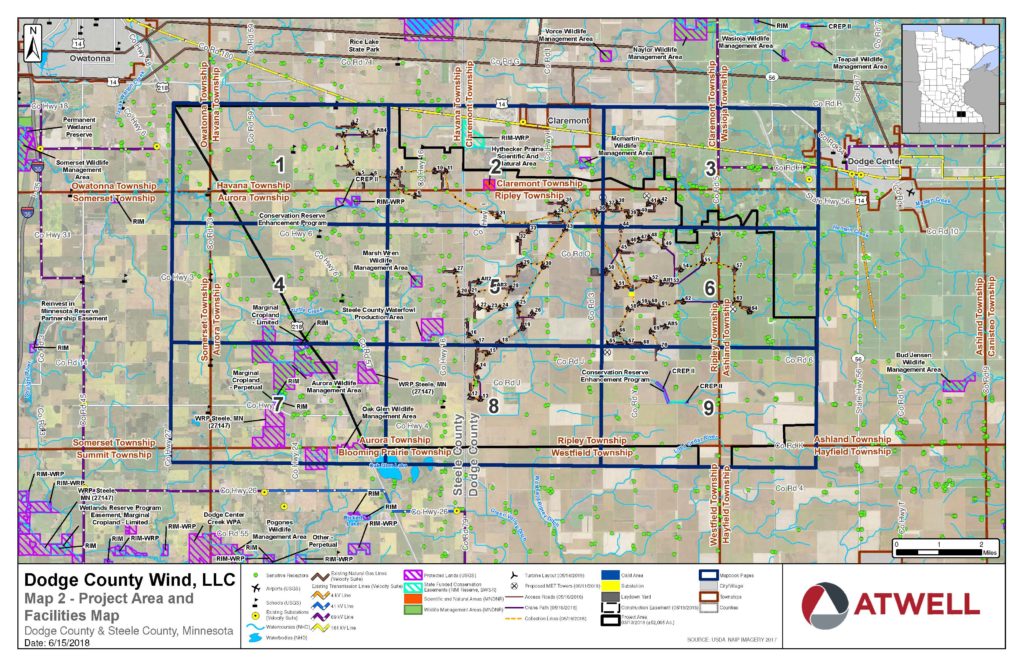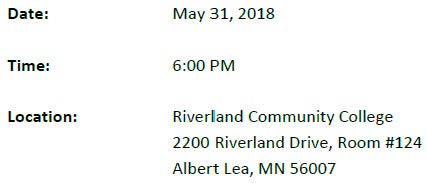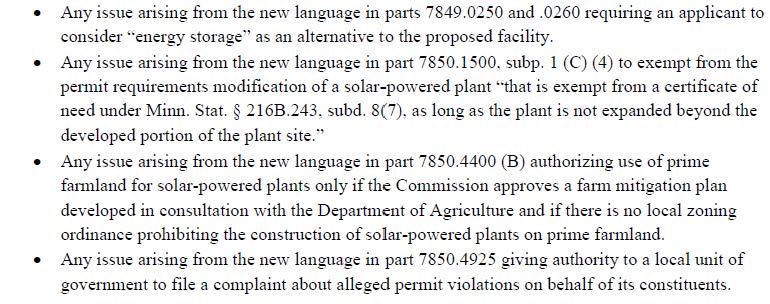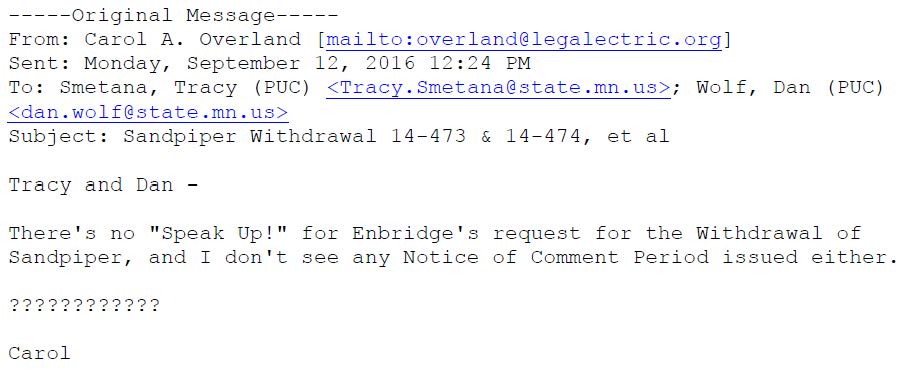
Oh my… just in, a request to suspend the permitting schedule for Dodge County Wind, the Certificate of Need, the wind site permit, and to WITHDRAW the transmission route permit!
There are 3 Dodge County Wind dockets, a Certificate of Need (17-306), wind siting (17-307), and transmission (17-308). Process wise, it goes to PUC for approval, and the PUC will probably announce a comment period in all 3 dockets. Then Commission will meet, and approve the withdrawal of the transmission without prejudice, so they can refile when they have a workable plan. That withdrawal process will take some time.
That time is an issue, because I don’t see any way they can come up with a transmission plan and get it through the MISO transmission studies to get a permit and start construction by year end. Tax credit implications — they have a problem.
As to the suspension of Certificate of Need and wind siting application proceedings, I’d like to see them dismissed without prejudice also, not suspended, gumming up the works at the Commission. We shall see.
This transmission was absurd from the get-go, a 345kV line with what, a 2,200MVA capacity, for a 170 MW project? They said it was part of a regional interconnection, from the application:

Oh, really? Don’t see it in the MISO MTEP. It’s not… and it’s a radial line, and you just don’t build short radial 345kV lines!
Here are Dodge County Wind’s requests for suspension and withdrawal:
“On August 9, 2019, DCW withdrew its MISO interconnection queue position no. J441, because of the significant interconnection costs associated with that queue position.”
Oh my… what does the MISO DPP Report have to say about that? Just search this report, issued July 25, 2019, for “J441.”
I figured the PUC should have that MISO report in the record:



And check out the summary page on p. 149 of the 150 page pdf.
After getting the 345kV route alternatives “C” and “D” ejected, not to be considered in the FEIS, this is just the icing on the cake!!
Dodge Center Xmsn – Mission Accomplished!
Here’s some background info from just over a year ago:
Dodge County Wind info presentation
July 29th, 2018
From the very beginning, with Dodge County Concerned Citizens working hard to inform people of the project, all three dockets, and Dodge Center’s Tom Applegate going door to door and encouraging people to write comments and send photos showing how the transmission line would affect their neighborhood in Dodge Center, this public input helped call the entire project into question. With the DEIS rejecting transmission alternative routes C and D, and with the MISO interconnection study showing so many network upgrades needed at a very high cost, this project is no longer viable. The people affected by this project have had a tremendous impact.
Freeborn Wind transmission hearing TONIGHT!
May 31st, 2018

Tonight is the public hearing, using the “Alternative Review Process,” for the transmission for the Freeborn Wind Project, the very same project that has been recommended be denied by the Administrative Law Judge:
WE WON!!! ALJ Recommend Freeborn Permit be DENIED, or…
Be there or be square:

What’s at issue? Most important is “need” and lack thereof. Under Minesota Rules, need may not be addressed in the environmental review:
BUT, where there is no Certificate of Need, issues of size, type and timing MAY be addressed — the prohibition of addressing need only applies where a Certificate of Need has been issued:
7850.4200 FACTORS EXCLUDED.
When the Public Utilities Commission has issued a Certificate of Need for a large electric power generating plant or a high voltage transmission line or placed a high voltage transmission line on the certified HVTL list maintained by the commission, questions of need, including size, type, and timing, questions of alternative system configurations, and questions of voltage shall not be factors considered by the commission in deciding whether to issue a permit for a proposed facility.
There is no Certificate of Need required or issued for this project, and so “questions of need, including size, type, and timing, questions of alternative system configurations, and questions of voltage” are fair game.
In this case, it’s particularly relevant where the ALJ has recommended the project site permit be denied! No project, no transmission needed.
Off to Albert Lea!
Comments due – Minn. R. Ch. 7849 & 7850 Rulemaking
May 1st, 2017
 Comments on the Minn. R. Ch. 7849 and 7850 rulemaking are due next Monday! Are you making any progress? Info on who, what, where, why, when of filing comments is here:
Comments on the Minn. R. Ch. 7849 and 7850 rulemaking are due next Monday! Are you making any progress? Info on who, what, where, why, when of filing comments is here:
What to comment on? 
 Here are the latest draft rules:
Here are the latest draft rules:
Get to it!
Sandpiper Withdrawal? Comments filed today!
September 12th, 2016
Today was Deadline #1 for Comments on NDPC’s Petition for Withdrawal of the Sandpiper pipeline Certificate of Need and Route applications. Here’s what was filed:
Yup, that’s it. My Sandpiper transmission clients weighed in. I’ve been watching the docket, watching the inbox for service…. NO other comments, nothing, nada…
Just get to it. Quick – take a few minutes and send a missive to the Public Utilities Commission encouraging them to allow Enbridge to withdraw their application for the Sandpiper pipeline WITH PREJUDICE so that they can’t refile it again. Send to:
Daniel P. Wolf, Executive Secretary (dan.wolf@state.mn.us) Minnesota Public Utilities Commission 121 Seventh Place East, Suite 350 Saint Paul, MN 55101-2147
Ann O’Reilly and James La Fave, Administrative Law Judges
Office of Administrative Hearings
600 North Robert Street
P.O. Box 64620
St. Paul, MN 55164-0620
But it doesn’t end there, with zip comments… it gets weirder. I’d saw there was no notice from the PUC about a comment period, nothing. Here’s what they did with Hollydale, Notice, and there was a comment period and reply comments! In that docket, Xcel Energy filed to withdraw its Hollydale applications on December 10, 2013, and this notice was issued on January 10, 2014:
Here’s what we got:
And when I asked:
Here’s the response:
Oh my… what do I do with that? Guess I write a post about it!!!
The rulemaking process — nothing changes…
September 13th, 2015
Many thanks to the “little birdie” who brought this decades old report to my attention:
Yes, this is a report from the Minnesota Legislative Auditor from 1993, and if you read it, you’ll see little has changed is so many years… The issues raised are issues we’ve been raising in the Public Utilities Commission rulemaking for Minn. R. Ch. 7849 and 7850 (Certificate of Need and Siting/Routing). AAAAAAAAAAAACK!
For example, from the Summary:
For example, in the PUC Rulemaking for 7849 and 7850 (PUC Docket 12-1246), it’s been an over two-year-long process, and few are showing up anymore. We weigh in, some things are taken into account in the drafts, and then that disappears from the next draft. How can it feel like anything but a colossal waste of time? Yet if we weren’t there, the utilities would get everything they want. And as with the utility Certificate of Need and Siting/Routing processes, rulemaking has the same notice and public participation problems. It’s all the same, deja vu all over again.
… and also from the report …
Does this sound familiar?
So what is the bottom line of this report?
Also, we recommend the following additional changes to the Administrative Procedure Act:
… and …
In addition to changing the APA and other statutes that govern agency rulemaking, we recommend that:






